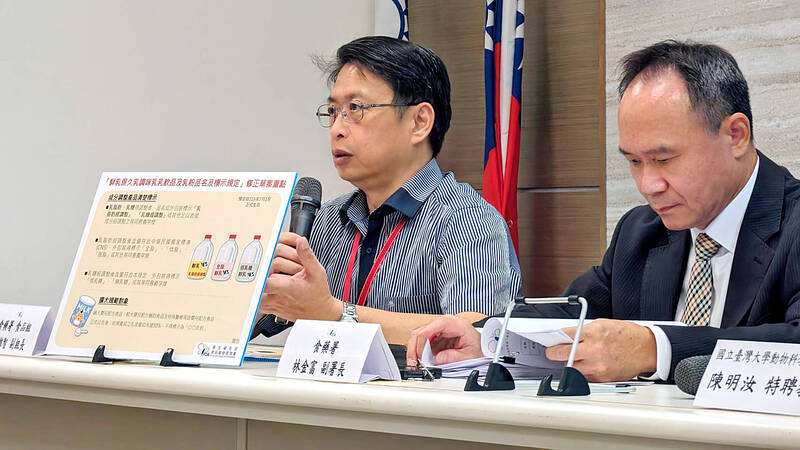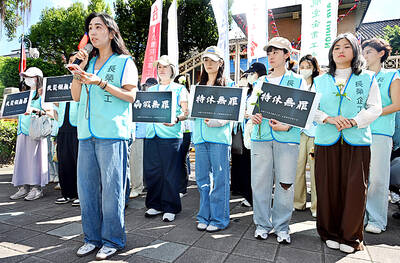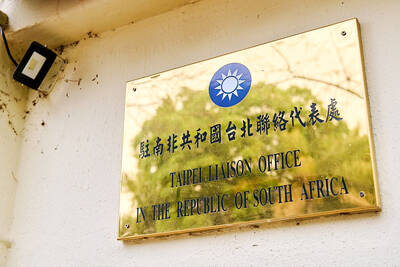The Food and Drug Administration (FDA) yesterday published revised regulations for naming and labeling milk products, stipulating that milk with a shelf life of 30 days or more should be called “extended shelf-life fresh milk” from July next year.
The revisions to the Regulations Governing the Product Names and Labeling of Prepackaged Fresh Milk, Sterilized Milk, Flavored Milk, Milk Drink and Milk Powder (鮮乳保久乳調味乳乳飲品及乳粉品名及標示規定) are intended to help consumers better understand different milk products based on their labels, FDA Deputy Director-General Lin Chin-fu (林金富) said.
The revisions are subject to a 60-day public comment period, Lin said.

Photo: CNA
FDA Food Safety Division Deputy Director Cheng Wei-chih (鄭維智) said the changes includes the newly added product names of “long-lasting fresh milk” (長效鮮乳) and “extended shelf-life fresh milk” (延長保存期限鮮乳).
They refer to fresh milk that has undergone high-temperature treatment meeting a certain temperature-time requirement, filled in a clean and sterilized environment similar to aseptic filling, and have a shelf life of 30 days or longer, he said.
The amended regulations on the names of extended shelf-life fresh milk is to go into effect on July 1 next year, so milk products produced from that day on must adhere to the requirement, while other amended regulations take effect on July 1, 2026, Lin said.
As most domestic fresh milk products have a shelf life of 14 days, while some imported products have a shelf life of 30 to 90 days, the Ministry of Agriculture suggested that the FDA help consumers understand the differences through product labels, Cheng said.
Under the 2013 Agreement Between New Zealand and the Separate Customs Territory of Taiwan, Penghu, Kinmen and Matsu on Economic Cooperation, tariffs on dairy products from New Zealand would be reduced to zero from Jan. 1 next year.
The local dairy industry has been calling for the government to help differentiate local fresh milk products from imported extended shelf-life fresh milk products, as it fears consumers would favor relatively cheaper imported milk with a longer shelf life because they cannot tell the difference.
Another revision concerns the font size of liquid milk product labeling, Cheng said.
Based on the product’s volume, the font size must be at least 0.4cm for 300ml or less of milk, at least 0.8cm for 301ml to 600ml of milk, and at least 1.2cm for 601ml or more of milk, he said.
The revisions also require clearer disclosures regarding milk fat and lactose modifications.
Milk fat adjustments that meet the national standards for whole milk, low-fat milk or skim milk can use such wording on packaging, and lactose adjustments that meet the standards for low lactose or lactose-free milk can also be marked on product packages, Cheng said.
The regulations would be expanded to include infant formula, follow-up infant formula and infant formula for special medical purposes, he said.
The rules stipulate that these products can only be labeled as “milk powder” if they contain milk content of 50 percent or more, he

A drunk woman was sexually assaulted inside a crowded concourse of Taipei Railway Station on Thursday last week before a foreign tourist notified police, leading to calls for better education on bystander intervention and review of security infrastructure. The man, surnamed Chiu (邱), was taken into custody on charges of sexual assault, taking advantage of the woman’s condition and public indecency. Police discovered that Chiu was a fugitive with prior convictions for vehicle theft. He has been taken into custody and is to complete his unserved six-month sentence, police said. On Thursday last week, Chiu was seen wearing a white

The Taoyuan Flight Attendants’ Union yesterday vowed to protest at the EVA Air Marathon on Sunday next week should EVA Airway Corp’s management continue to ignore the union’s petition to change rules on employees’ leave of absence system, after a flight attendant reportedly died after working on a long-haul flight while ill. The case has generated public discussion over whether taking personal or sick leave should affect a worker’s performance review. Several union members yesterday protested at the Legislative Yuan, holding white flowers and placards, while shouting: “Life is priceless; requesting leave is not a crime.” “The union is scheduled to meet with

‘UNITED FRONT’ RHETORIC: China’s TAO also plans to hold weekly, instead of biweekly, news conferences because it wants to control the cross-strait discourse, an expert said China’s plan to expand its single-entry visa-on-arrival service to Taiwanese would be of limited interest to Taiwanese and is a feeble attempt by Chinese administrators to demonstrate that they are doing something, the Mainland Affairs Council said yesterday. China’s Taiwan Affairs Office (TAO) spokesman Chen Binhua (陳斌華) said the program aims to facilitate travel to China for Taiwanese compatriots, regardless of whether they are arriving via direct flights or are entering mainland China through Hong Kong, Macau or other countries, and they would be able to apply for a single-entry visa-on-arrival at all eligible entry points in China. The policy aims

COUNTERMEASURE: Taiwan was to implement controls for 47 tech products bound for South Africa after the latter downgraded and renamed Taipei’s ‘de facto’ offices The Ministry of Foreign Affairs is still reviewing a new agreement proposed by the South African government last month to regulate the status of reciprocal representative offices, Minister of Foreign Affairs Lin Chia-lung (林佳龍) said yesterday. Asked about the latest developments in a year-long controversy over Taiwan’s de facto representative office in South Africa, Lin during a legislative session said that the ministry was consulting with legal experts on the proposed new agreement. While the new proposal offers Taiwan greater flexibility, the ministry does not find it acceptable, Lin said without elaborating. The ministry is still open to resuming retaliatory measures against South